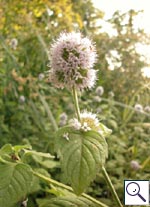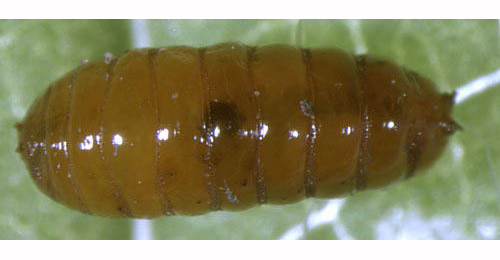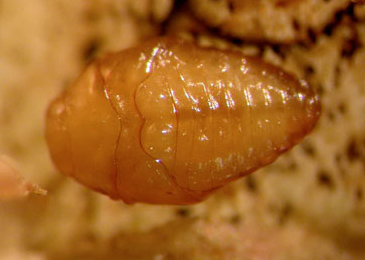|
||||||
|
MENTHA. Mints. [Lamiaceae] |
|
|
Seven species of Mentha are recorded in Britain. These included the native Water Mint (M. aquatica), Corn Mint (M. arvensis), Pennyroyal (M. pulegium) and Round-leaved Mint (M. suaveolens). Pennyroyal (M. pulegium) is protected under Schedule 8 of the Wildlife and Countryside Act, 1981 and in Northern Ireland under Schedule 8 of the Wildlife (Northern Ireland) Order, 1985.. Eight British miners are recorded on Mentha. The agromyzid Napomyza scrophulariae is recorded feeding in both seed heads and stems of Digitalis pupurea and possibly Scrophularia nodosa, Verbascum and Menthain Britain. A key to the European miners recorded on Mentha is provided in Bladmineerders van Europa. |
 Water Mint Mentha aquatica |
Key for the identification of the known mines of British |
Note: Diptera larvae may live in a corridor mine, a corridor-blotch mine, or a blotch mine, but never in a case, a rolled or folded leaf, a tentiform mine or sandwiched between two more or less circular leaf sections in later instars. Pupation never in a cocoon. All mining Diptera larvae are leg-less maggots without a head capsule (see examples). They never have thoracic or abdominal legs. They do not have chewing mouthparts, although they do have a characteristic cephalo-pharyngeal skeleton (see examples), usually visible internally through the body wall. The larvae lie on their sides within the mine and use their pick-like mouthparts to feed on plant tissue. In some corridor miners frass may lie in two rows on alternate sides of the mine. In order to vacate the mine the fully grown larva cuts an exit slit, which is usually semi-circular (see Liriomyza huidobrensis video). The pupa is formed within the hardened last larval skin or puparium and as a result sheaths enclosing head appendages, wings and legs are not visible externally (see examples). See Key to non-Diptera. |
1a > Leaf-miner: Mine linear, whitish, both upper and lower surface. Pupation internal, at the end of the mine with the anterior spiracles projecting through the epidermis (Spencer, 1976: 433). Upper-surface, less often lower-surface corridor. Frass in isolated grains. Pupation within the mine, usually in a lower-surface puparial chamber. A long whitish upper surface corridor, which eventually goes lower surface. |
|
Chromatomyia horticola (Goureau, 1851) [Diptera: Agromyzidae]. |
1b > Leaf-miner: Mine beginning with a small spiral, later developing into a greenish blotch, frequently at leaf margin, brown when old. Pupation internal or external (Spencer, 1972b: 89 (figs 296), 90). Upper surface. The mine begins as a short, compact brown spiral, followed by a secondary blotch, often at the leaf margin. Often spiral and blotch are separated by a recognisable corridor segment. Secondary feeding lines conspicuous (in fresh mines). Pupation outside the mine; sometimes pupation occurs earlier but then the exit slit already has been made, and the spiracula do not penetrate the plant epidermis. The mine starts with a small spiral and then develops into a greenish blotch (frequently on the leaf margin) which turns brown as it ages (British Leafminers). |
|
Phytomyza tetrasticha Hendel, 1927 [Diptera: Agromyzidae]. |
1c > Leaf-miner: Mine beginning with a small spiral, later developing into a greenish blotch, brown when old. Pupation frequently in mine (Spencer, 1972b: 90). The mine, that may be upper- or lower-surface, generally starts with a tight spiral. Its loops are so tight that the leaf tissue dies off and turns red; nevertheless the corridor remains well visible. Later the corridor widens and finally a large secondary blotch develops around the initial spiral. Frass at first in two rows of grains, later in pearl chains. Feeding lines very clear. Pupation now within, then outside the mine. |
|
Phytomyza obscura Hendel, 1920 [Diptera: Agromyzidae]. |
1d > Leaf-miner: An irregularly linear mine which may become a secondary blotch. Pupation normally external, but not infrequently the puparium remains in the leaf at the prepared exit slit (Spencer, 1972b: 86 (fig. 289), 88; Spencer, 1976: 467 (fig. 822, 468). Upper-surface corridor, often branched and crossing itself, but not forming a secondary blotch. Frass mainly in thread fragments. Pupaption generally outside the mine. Sometimes pupation occurs within the mine, near the lower epidermis, but then already an exit slit has been made, and the spiracula do not penetrate the epidermis (Hering, 1924a, 1957a). |
|
Phytomyza petoei Hering, 1924 [Diptera: Agromyzidae]. |
1c > Leaf-miner: A linear-blotch mine, first instar mine is linear, later developing into a conspicuous white blotch. Frass greenish diffused (Spencer, 1972b: 46, 47 (fig. 138); Spencer, 1976: 166). The mine begins with a long, upper-surface, slender corridor. After a moult the larva changes its behaviour, and makes a large, upper-surface primary blotch without apparent feeding lines. Often the blotch overruns more or less the initial corridor. Frass in the corridor liquified to form a wide green band, with a few tiny black granules along the sides. Pupation outside the mine. A narrow gallery leading to a largish blotch on the upper surface. Frass is green and indistinct in the gallery - small grains may be seen at the gallery edge. |
 Amauromyza labiatarum puparium Image: © Willem Ellis (Bladmineerders van Europa) |
|
Amauromyza labiatarum (Hendel, 1920) [Diptera: Agromyzidae]. |
|
Key for the identification of the known mines of British |
|
Note: The larvae of mining Coleoptera, Hymenoptera and Lepidoptera may live in a corridor mine, a corridor-blotch mine, a blotch mine, a case, a rolled or folded leaf, a tentiform mine or sandwiched between two more or less circular leaf sections in later instars. Larva may pupate in a silk cocoon. The larva may have six legs (although they may be reduced or absent), a head capsule and chewing mouthparts with opposable mandibles (see video of a gracillarid larva feeding). Larvae of Hymenoptera and Lepidoptera usually also have abdominal legs (see examples). Frass, if present, never in two rows. Unless feeding externally from within a case the larva usually vacates the mine by chewing an exit hole. Pupa with visible head appendages, wings and legs which lie in sheaths (see examples). |
1a > Leaf-miner and case-bearer: Blotch mines reaching the edge of the leaf, initially pale green turning brownish white, are caused by the larva feeding on the underside of a leaf. The fully developed case is slender, shining black brown, about 9 mm long. Towards the end a narrow, transparent yellowish ventral keel. Mouth angle 50-60°. Cases on the leaf underside. |
|
Coleophora albitarsella Zeller, 1849 [Lepidoptera: Coleophoridae]. |
1b > Leaf miner, but not a case-bearer |
2a > Leaf-miner: Young larvae make small, brown, full depth blotch mines without frass in the young leaves, from within the protection of a spinning. Later they cause upper-surface window feeding, while hidden among spun leaves. |
|
| Scrobipalpa artemisiella (Treitschke, 1833) [Lepidoptera: Gelechiidae]. |
2b > Leaf-miner: Upper-surface, transparent blotch that begins at the leaf margin, generally at the underside of the leaf. Oviposition site covered by a shining brown drop of hardened secretion. Frass in grains or thread fragments. |
 Trachys scrobiculatus pupa, dorsal Image: © Jean-Yves Baugnée (Bladmineerders van Europa) |
|
Trachys scrobiculatus Kiesenwetter, 1857 [Coleoptera: Buprestidae]. |
| Last updated 06-Jul-2019 Brian Pitkin | ||
